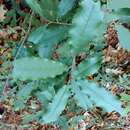en
names in breadcrumbs


Photinia serratifolia (syn. Photinia serrulata), commonly called Taiwanese photinia[2] or Chinese photinia is a flowering shrub or tree in the flowering plants family Rosaceae, found in mixed forests of China, Taiwan, Japan, the Philippines, Indonesia, and India.[3]
The tree is evergreen, with white flowers emerging in spring accompanied by red-colored leaves, and red fruits growing in autumn. It grows typically 4–6 m (13–20 ft), sometimes up to 12 m (39 ft), tall.[3] Its leaves are toxic due to the presence of cyanogenic glycosides.[4] The flower, blossoming in spring, typically lasts for one to two weeks. Its flowers are known to have a strong scent similar to that of human semen. The flower have bell-shaped sepal split into five lobes, and around 20 stamens. Ovary contain two to four locules, with one ovule in each locule. The tree produces high amount of bright, red colored fruits that are small pomes with diameters ranging from 4–12 millimetres (0.16–0.47 inches), each containing one to four seeds. The fruit, ripen in autumn and survives through winter, is a food source to various kinds of birds, including thrushes, waxwings, and starlings. The seeds spread primarily through bird excretions. [3]
The tree is typically found at altitudes from sea level to 2,500 metres (8,000 ft). It is found in mixed forests of central and southern China, Taiwan, Japan, the Philippines, Indonesia, and India.[3]
Three varieties of the species are recognized in the Flora of China:[3][5]
The tree is widely used as a greening plant in some mainland Chinese cities, due to the relative ease to plant and maintain, and the tree being less demanding for its surrounding environments. In Wuhan, where the tree is in its native range, the tree is planted by the sides of all major avenues, as well as in the Wuhan University. However, due to the strong, semen-like odor from its flowers filling the entire city in spring, some Wuhan residents have complained that the tree should be removed and other trees should be planted instead.[6][7]
{{cite journal}}: CS1 maint: uses authors parameter (link) Photinia serratifolia (syn. Photinia serrulata), commonly called Taiwanese photinia or Chinese photinia is a flowering shrub or tree in the flowering plants family Rosaceae, found in mixed forests of China, Taiwan, Japan, the Philippines, Indonesia, and India.
 Photinia serratifolia
Photinia serratifolia